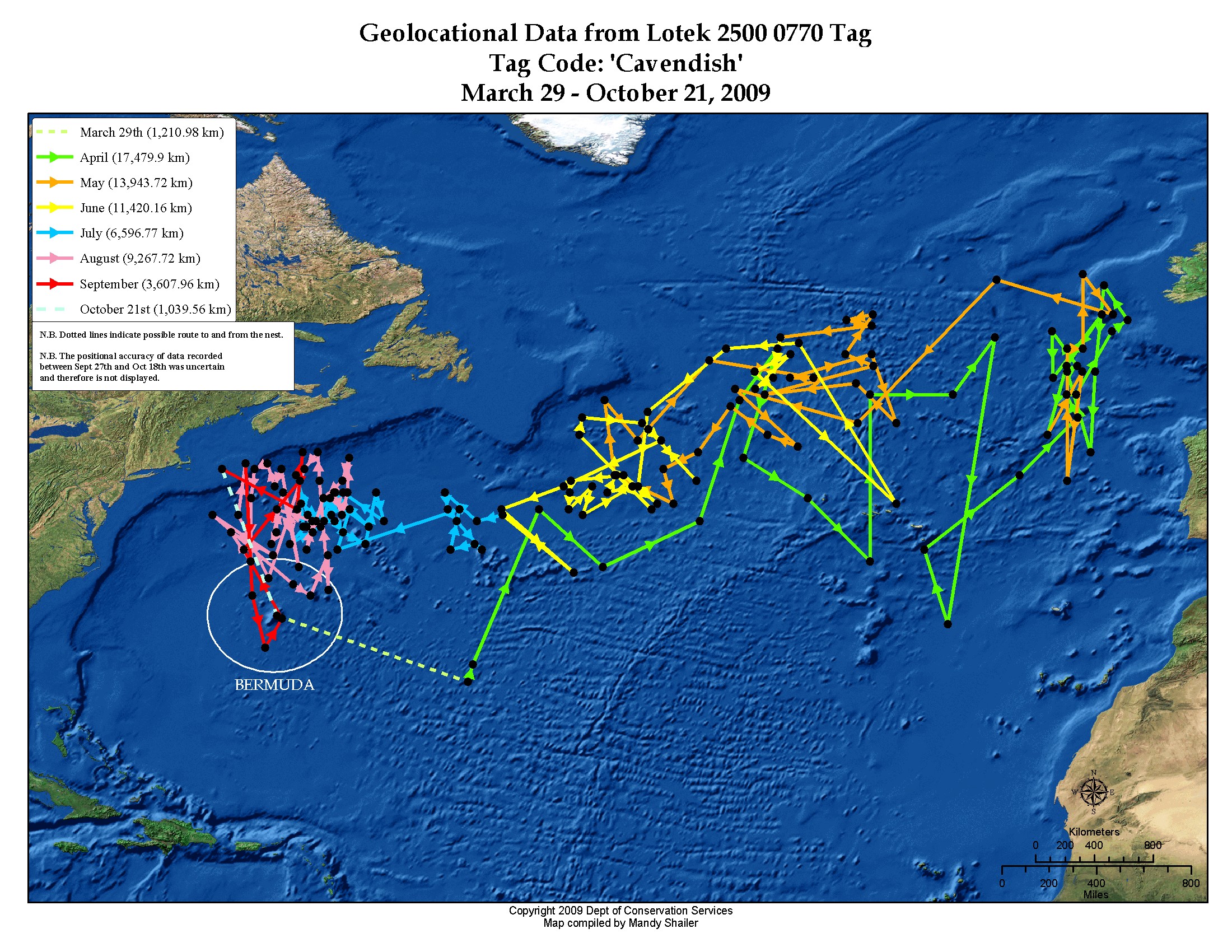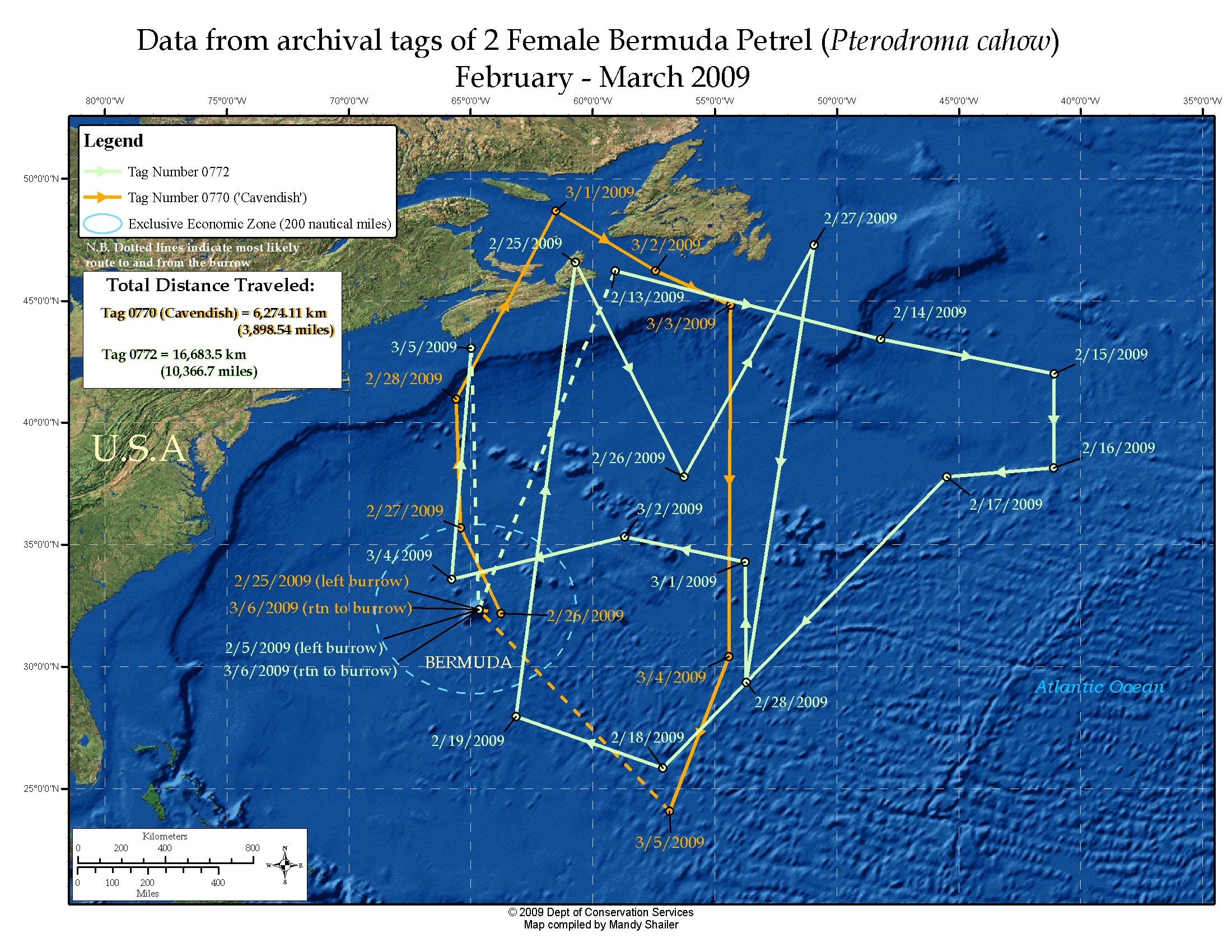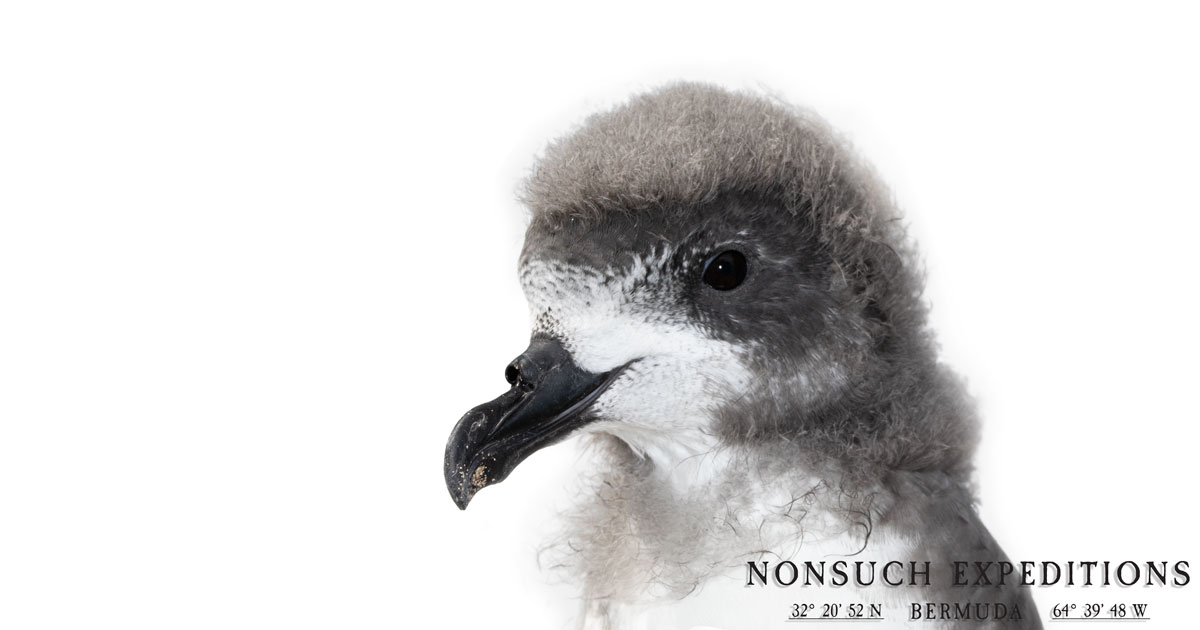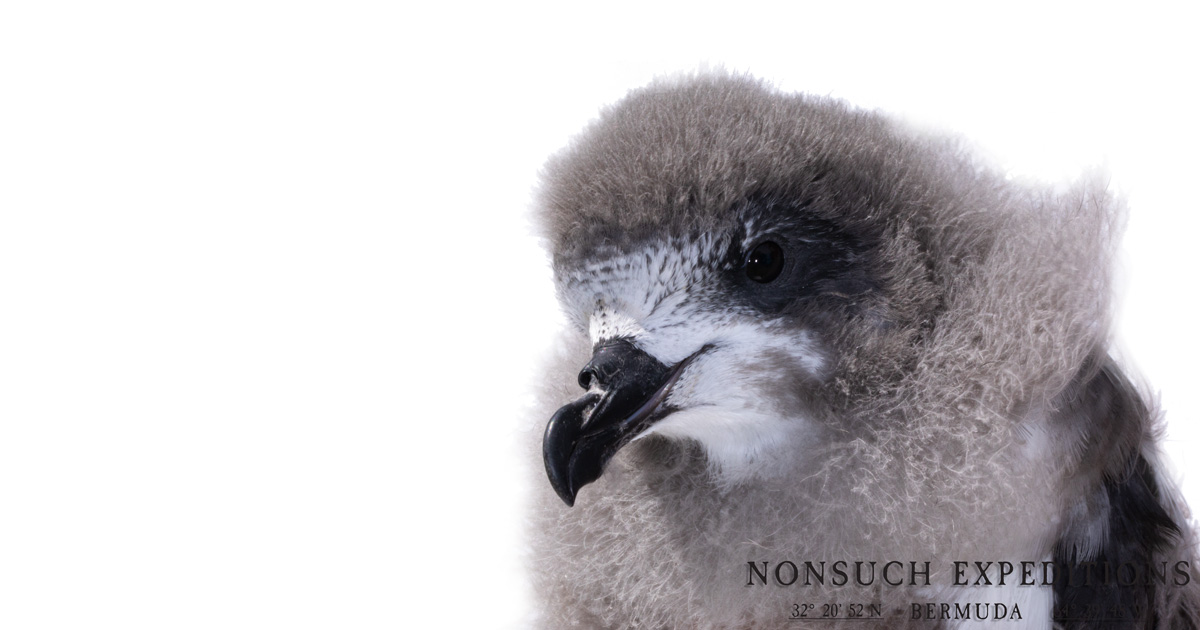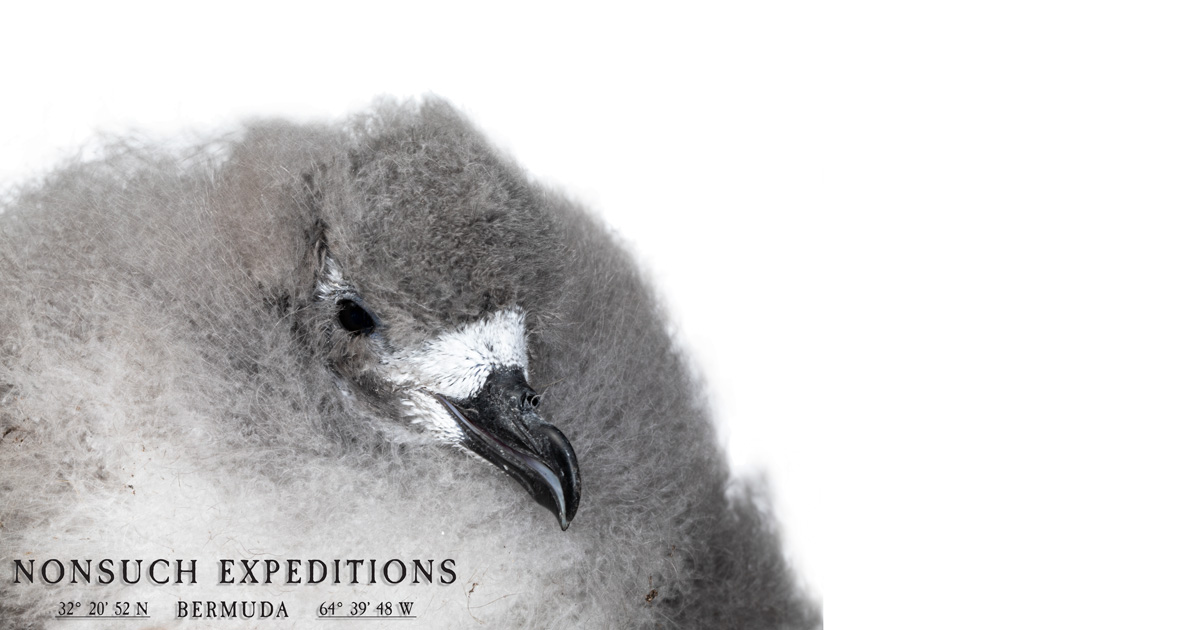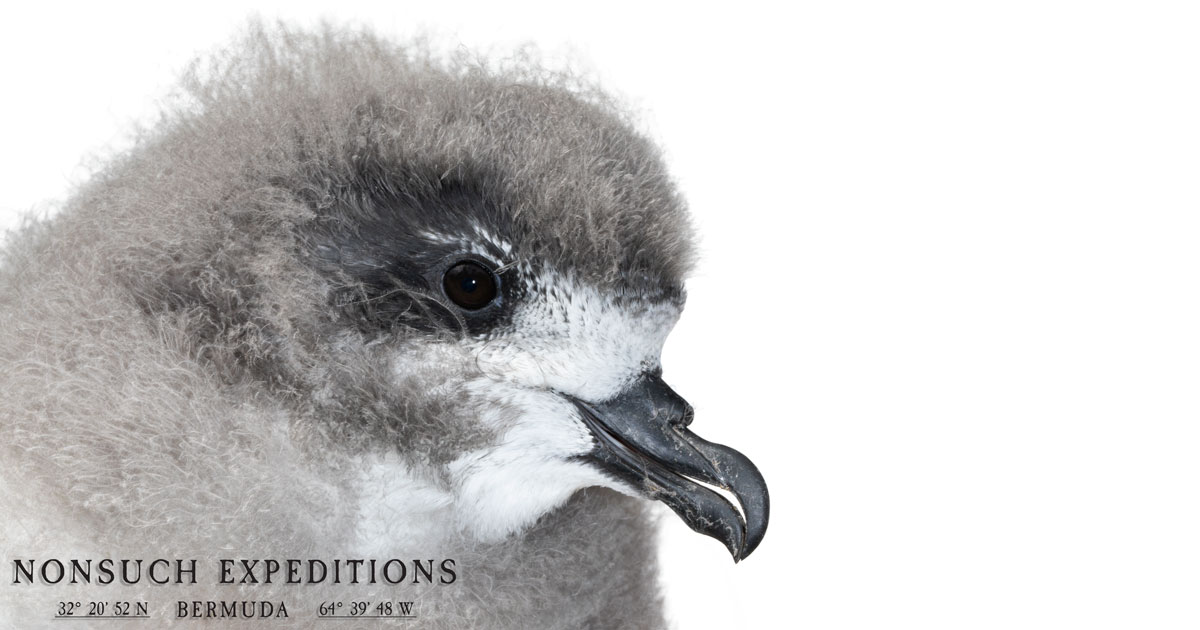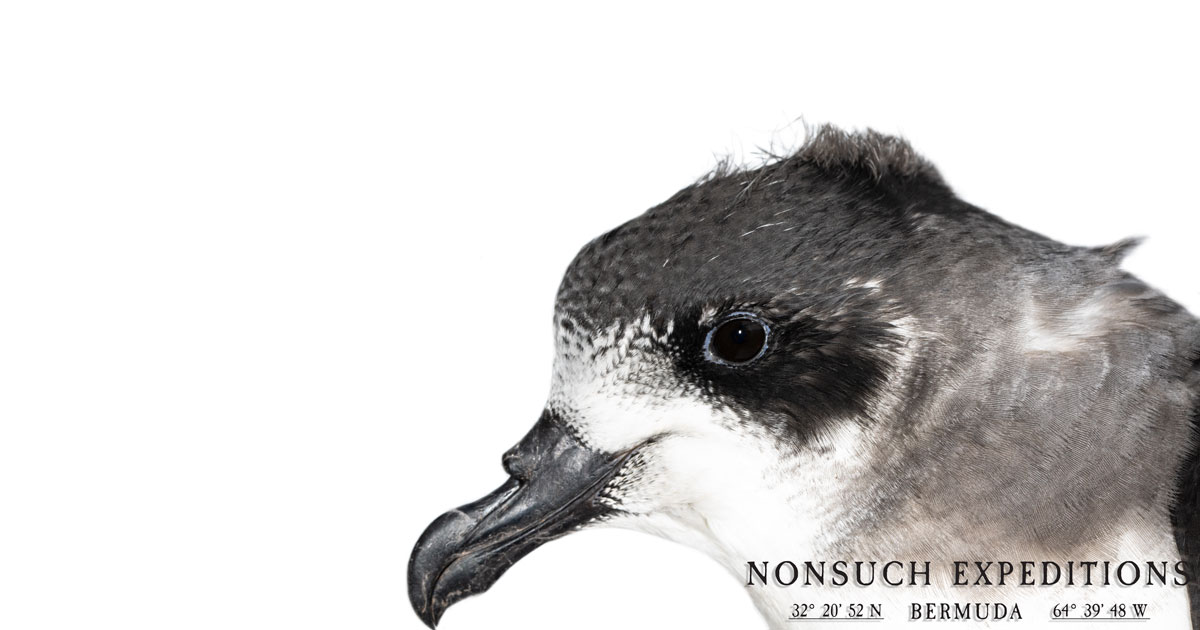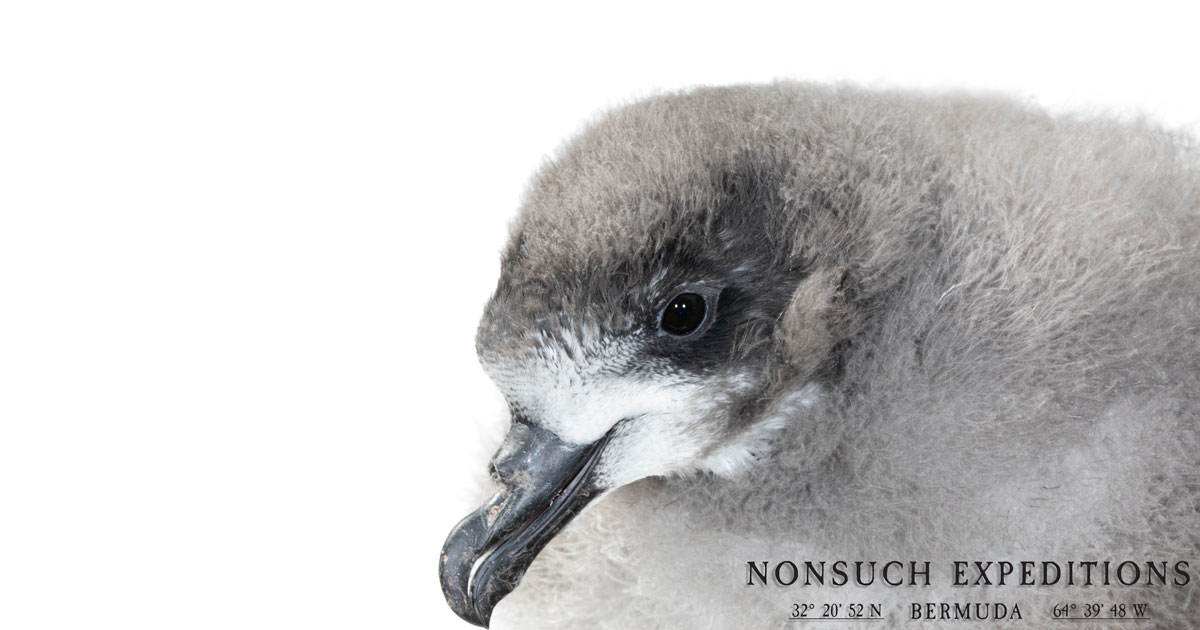Join Jeremy Madeiros as he inspects the nesting burrows in Nonsuch Island Translocation Colony A, and meets a few new chicks.
Cahow Talk at the BUEI - Season Update and New Research
Save The Date: Monday February 11th, 7:30 pm at the BUEI
The Nonsuch Expeditions present a Cahow Season Update with Jeremy Madeiros and our collaborators from Portugal and the Cornell Lab of Ornithology Bird Cam Team.
Jeremy will give a summary of last years record-breaking season and updates from this one.
You will also learn about upcoming research using GPS based geo-tagging and upgrades to the award winning CahowCam system at the start of what looks to be another amazing season.
BUEI Members: $20 Non-members: $25 Students: $12
Tickets available by phone or visiting the BUEI gift shop | 441.209-0204 I www.BUEI.bm
5 pm: Sushi Happy Hour and À la Carte Menu at Harbourfront
7:30pm: Lecture starts, BUEI Auditorium
Ticket holders are entitled to 10% off dinner at the Harbourfront (food only) before or after the lecture. Please call 295-4207 for reservations and be sure to mention the lecture. Cannot be combined with any other special offer.
The 1st CahowCam Chick has returned!
Backson the 2013 CahowCam chick has returned to Nonsuch Island and has laid an egg!
January 30th 2019 | Nonsuch Island Translocation Colony B:
Whilst conducting routine nest checks today “Backson” the Cahow chick from the first CahowCam Season in 2013 was found in Translocation Colony B on Nonsuch Island. Jeremy actually found her egg first, in a nest in the same burrow that she occupied last year, not being incubated, and then found her in an empty burrow a few feet away. It is not necessarily a problem for an egg to be left on its own for up to several days at a time and in this case she was more than likely taking a break from incubating exploring the neighborhood and wasn’t able to get back to her burrow by sunrise. She was put back in the correct burrow after her health check and will be checked on again later in the week.
She was named by Junior Explorer Sophie Rouja prior to fledging in 2013 based on a Winnie The Pooh story in which a note from Christopher Robin saying he would be "back soon" was misread as "Backson". This is what happens when a five year old picks the name :) yet ultimately proved appropriate as Backson was indeed back soon!
GPS being used in Cahow study
A multi-year collaboration has been launched with visiting researchers from MARE-ISPA and cE3c-FCUL (Portugal) who will work with the DENR and the Nonsuch Expeditions Teams to use GPS tags to track a cross-section of Cahows on their foraging journeys.
Jeremy Madeiros | Principal terrestrial Conservation Officer "The Cahow Recovery Program is committed to helping Bermuda's iconic National Bird recover from near-extinction and once again become an important part of the island's biodiversity. As such, we have always tried to utilize new management techniques and research technology in the program, so that potential threats to the Cahow can be anticipated, planned for and incorporated into ongoing management of the species.
Although we have managed to control threats to the Cahow on its nesting islands, establish new nesting colonies and greatly increase its breeding population, it is still critically endangered, and there is an incomplete understanding of its oceanic range and foraging areas. It is important that we understand where Cahows are finding their food at sea and whether, for example, areas where fishing pressure is concentrated or where offshore oil and gas exploration is planned may overlap with these foraging sites and possibly pose a threat to the birds.”
Geolocator Maps from 2009 study
Letizia Campioni | MARE-ISPA IU “Our project will enhance the ongoing Cahow Recovery Program by shedding light on their pelagic foraging behaviors and potential risks that they may encounter on the high-seas.”
Mónica C Silva | cE3c-FCUL “We are running a project with North East Atlantic Gadfly Petrels and we suspect that their foraging grounds may overlap exposing them to the same risks.”
The local Team has observed that over the past 2 seasons and continuing into this one, that foraging trips appear to be becoming shorter and more frequent. Cahows feed on cold water fish and squid traditionally found hundreds or even thousands of miles away in the North Atlantic basin, north of the Gulf Stream, but these shorter excursions raise the question as to where they may now be foraging, which this study will help answer.
Jeremy Madeiros | “Limited studies with geolocator tags in 2009-2010 made me realize that the Cahow can cover most of the North Atlantic Ocean in its yearly travels, but these had a large margin of error and were just a beginning for this study. I am excited about our collaboration with Letizia and Monica and the potential to focus in greater detail on important feeding areas for the Cahow and other aspects of its oceanic travels with these much more accurate GPS tags."
The longer-term geolocator tags register the time of day that the sun appears to rise and set and once this data is retrieved calculations are made to determine where in the world the subject would have had to be (within a 100 mile radius) for the sun to rise or set at the recorded time, giving their approximate location at sunrise and sunset each day for months on end.
GPS tag taped to tail feathers on Cahow
This season, the shorter-duration, but much more accurate GPS tags will be set to record the time required to contact the numerous GPS satellites at set intervals, which once retrieved can then be extrapolated to identify the GPS locations. In this way the tags do not need to process or calculate the actual GPS location in realtime which would require much larger batteries and processing power…
This allows the tags to weigh only 3 grams and when set to record at hourly intervals, the battery will last up to 2 weeks.
Jean-Pierre Rouja | The Nonsuch Expeditions “Not only will this data be useful to the Cahow Recovery effort, but we will integrate it into the STEAM Curriculum that we are developing with Cornell, giving students interactive real-world data to work with.”
The Portuguese Team is supported by a grant from The Mohamed bin Zayed Species Conservation Fund.
Female Cahow returns early, pair remain in nest for the day.
Watch LIVE as our Female Cahow has returned earlier than expected and pair will remain in the burrow for the day. Watch their interactions now.
The male had taken over incubation duties on the 14th and the female was expected to stay away for two to three weeks, so her return after only 7 days on the evening of the 21st was quite a surprise.
This is more than likely due to her finding a food source closer to Bermuda than expected as she usually needs to fly north of the gulf stream in the colder waters between Canada and the Azores to forage.
This also means that the male will still have plentiful fat reserves so won’t be ready to relinquish control of the egg just yet.
Cahows will not leave the burrow during daylight, so the situation gives our viewers an extended opportunity to watch the pair together.
Male Cahow returns to take over incubation duties
At roughy 7 pm on January 13th, almost 3 days after his mate had laid their egg, the male Cahow returned right on schedule.
They then spent the next several hours together until she headed out to sea leaving him to incubate their egg for the next few weeks whilst she regains her strength.
Once she returns they will alternate shorter shifts incubating the egg until if all goes well, after roughly 53 days, it hatches.
Watch LIVE now: CahowCam
CahowCam Season 7 starts as female lays her egg!
The 2019 CahowCam Nesting Season has officially started with the return of the female and the laying of her single egg in the early hours of January the 10th, exactly on schedule.
The incubation period is generally +/- 53 days, the first few weeks of which the male will take on whilst the female goes back out to sea to feed and regain her energy having just produced an egg almost a 1/3 of her body weight! Once she returns they will alternate shorter shifts on the egg until, if all goes well, it hatches in early March.
Jeremy Madeiros | Senior Terrestrial Conservation Officer (Bermuda Government)
I was happy to see the return of our CahowCam female last night just before midnight.
She flew in during the 35 to 40 knot gale just ahead of the cold front that came through, effectively using the winds as a fast lane to bring her back from her feeding grounds to the North.
Over the next 2 hours whilst I watched her preparing the nest and laying her egg, I could hear other Cahows calling in the background so it is clear that others came in with the same front.
As of 2 days ago 6 of the 18 nests in Translocation Colony A had returned birds and after a quick check this AM just ahead of the next cold front I can confirm that there are now birds in 9 of the 18 nests, 6 being females on eggs and 3 being males awaiting their mates return.
Over the next few weeks we will be incorporating “candling” into the nest check process that will allow us to track development of the chick embryos during the incubation period which usually lasts around 53 days.
J-P Rouja | Nonsuch Expeditions Team Leader and Conservation Tech Developer
“We had been watching for her return for the past few days and had alerted our Nonsuch Expeditions and Cornell followers to expect her over the next few nights, so it was amazing to see her show up exactly on schedule. As luck would have it her first activity was to rearrange the nest and in doing so she kicked some dried grass in front of the lens. Nonetheless out team and other late night viewers were able to watch her lay her single egg just after 1am, as Jeremy had predicted, within an hour of her return.”
Charles Eldermire | Bird Cams Project Leader Cornell Lab of Ornithology
“There's nothing quite like the happy, relieved surprise I felt watching the female Cahow amble into the nest burrow from the stormy darkness outside. I was also glad that despite her frenzied nest excavations, we were able to see her calm, determined focus as she laid a single egg. Everyone here is excited to see what the cahows teach us this season, and we're looking forward to sharing their journey with viewers across the world.”
Watch the ongoing nesting activity on our newly upgraded HD CahowCam LIVE stream or sign up for our Newsletter selecting the CahowCam alert option to be notified by email of significant nesting season milestones.
CahowCam star expected to return to lay egg over next few nights.
The countdown is on as we await the return of our female Cahow which in 2017 returned on the 10th and in 2018 on the 12th of January, laying her single egg within minutes of arrival.
Watch the newly upgraded HD CahowCam LIVE stream at www.nonsuchisland.com or sign up for our Newsletter selecting the CahowCam alert option to be notified by email as soon as our Team notices her return.
The male will usually arrive shortly after the egg is laid, taking on the first incubation shift of 2 to 3 weeks allowing her to go back out to sea and regain her strength. If all goes well, the entire incubation generally lasts around 60 days with the chick hatching in early March.
Our followers around the World spent over 15 million minutes watching our Cam over the past 2 nesting seasons and we have many new improvements and features in store for this year as we expand upon our partnership with the Cornell Lab of Ornithology.
Cornell Lab of Ornithology Director visits Nonsuch Island
John W. Fitzpatrick, Jeremy Maderios & J-P Rouja at the Nonsuch Expeditions CahowCam burrow.
As the Nonsuch Expeditions Team prepared to broadcast what is setting up to be another record breaking Cahow nesting season, John W. Fitzpatrick the Director of the Cornell Lab of Ornithology paid us a visit:
“After following the story of Bermuda’s iconic Cahow throughout my entire ornithological career, it was a real thrill finally to see Nonsuch Island firsthand and to meet its conservation and storytelling heroes. My regret, of course, is that we missed seeing the birds themselves by just a few days, but this only ensures Molly’s and my return during the breeding season. It is a privilege for the Cornell Lab of Ornithology to be streaming Nonsuch Expedition’s “CahowCam” to the world. I look forward to following along especially closely this year, now that I’ve personally looked down into that nest burrow! Best wishes for continued successes during the 2019 breeding season.”
Stay tuned this Season for the many new features that we are developing with Cornell and be sure to sign up to our Newsletter selecting the CahowCam alerts option to receive notices of significant events as they happen.
2019 Cahow Nesting Season off to a great start!
The upcoming 2019 Cahow Nesting Season is off to an early start with breeding pairs returning to their underground burrows on the Nonsuch Island Nature Reserve and its surrounding islets earlier than expected. Watch CahowCam LIVE Now.
Principal Terrestrial Conservation Officer at the Department of the Environment and Natural Resources (DENR) Jeremy Madeiros: "Many of the birds are returning a week ahead of normal, possibly due to favorable weather and good amounts of food in their traditional feeding grounds in the cold waters north of the Gulf Stream. The remaining breeding pairs should be returning by the first week in November and all the birds examined thus far are in good condition which bodes well for a promising breeding season.”
"Conditions this year seem similar to last year when the closer proximity of food led to more frequent feeding visits which contributed to the record number of chicks (71) fledging, breaking the old record by 10. We are looking forward to see how many new pairs lay an egg for the first time this season as we had record numbers of new prospecting pairs last season.
Last year’s record number of 124 breeding pairs will hopefully also increase due to the number of new pairs coming on-line, and may approach 130 pairs; this represents a significant recovery, thanks to an intensive management program, from the original number of just 17 to 18 pairs in the 1960s.”
Cornell Lab of Ornithology Bird Cams Project Leader, Charles Eldermire: "Viewers have been asking when the CahowCam would return, and we’re excited to share these intimate views of the Cahow pair during their November courtship. The new camera will allow us to see their breeding season progress in exquisite detail, capturing the complexity of the cahows' lives at a new scale. These recordings are hopefully the first of many, chronicling the continued recovery of these petrels thanks to the efforts of everyone involved in their conservation."
Nonsuch Expeditions Team Leader and CahowCam developer Jean-Pierre Rouja: “ Our star CahowCam pair were amongst the first to return with the female arriving on the night of October 25th and her mate on the 26th. The recently upgraded HD camera system was already streaming LIVE which allowed our followers from around the world to get a preview of the reunited pairs’ courtship activities, after having spending several months apart. They spent the first few days courting, preening, nest building and resting which will continue on and off for the next few weeks all of which can be viewed LIVE via the CahowCam page. If all goes well they will then spend December out at sea feeding and re-energizing before the female returns in early January to lay her single egg.”
"With the support of the DENR, this will be the seventh Season that the Nonsuch Expeditions CahowCam live-streams to the world. Over the past two seasons, through our new collaboration with the Cornell Lab of Ornithology, hundreds of thousands of viewers, including students from around the world, watched over 15 million minutes of CahowCam video!
As part of our ongoing efforts to leverage technology to assist with Conservation efforts we will be bringing several new features online this upcoming season which should extend our reach and increase public engagement even further. In parallel, we continue to develop our K-12 STEAM curriculum with Cornell which is also being pegged to the Cambridge system for Bermuda and International use. Educators should contact us via this website for more and sign up for our Newsletter."
Juvenile Mahi-Mahi found in Sargassum
The recent waves of Sargassum weed that have made their way to Bermuda have as usual contained a wide variety of fauna including juvenile pelagic fish.
Above and beyond the usual sargassum community the variety of species found depends upon the currents and time of year, and recently it has included juvenile Mahi-Mahi in the 1 inch to 4 inch range, several of which were collected by Species Collector Chris Flook.
Nonsuch Expeditions lead photographer Jean-Pierre Rouja documented these different stages some of which can be seen here.
Fortunately Bermuda has not thus far seen the destructive amounts of Sargassum that has flooded the Caribbean over the past few months, where it has been overwhelming various coastlines in some places so thick that turtles and dolphins have drowned, not being able to break through to the surface to breathe. The thick matts when amassed in a bay or coastline quickly start rotting and turn toxic killing all of the fish in the proximity as well.
At least for now, the Sargassum they are having problems with is not coming out of the Sargasso Sea, but instead from further South where it has been increasing in recent years. It remains to be seen if the conditions that have caused those increases will eventually affect Bermuda as well…
For more information please visit the Sargasso Sea Commission Website
Big thanks the BIOS for the pop-up studio space.
Time-lapse & report from 2018 CahowCam season
Click above to view Time-lapse of 2018 CahowCam season
Charles Eldermire | Cornell Lab of Ornithology:
"We've been excited to watch the Cahow Cam community's response over the last two years to watching this uber-rare subterranean seabird's breeding attempts. Hundreds of thousands of viewers have spent over 15 million minutes watching the young cahow transform into a sleek juvenile. Beyond just watching, they've also shared their observations on social media, recruited new viewers into the fold, and been ambassadors for raising awareness of the tenuous success of the cahow recovery effort. We're looking forward to learning more together in 2019!"
J-P Rouja | Nonsuch Expeditions Team Leader:
This is the 6th Season that under our ongoing Nonsuch Expeditions project we have been streaming LIVE from the underground nesting burrows in Translocation Colony "A" on Nonsuch Island in Bermuda. The K-12 and Cambridge curriculum that we are developing with Cornell will further extend our reach into classrooms in Bermuda and around the world! To obtain resources, teachers should contact us or signup for our Newsletter selecting the educator options.
Please see the 2018 report below from Jeremy Madeiros, Chief Terrestrial Conservation Officer:
2018 Sees Record-breaking Cahow Nesting Season
Bermuda’s National Bird, the endemic and critically endangered Bermuda petrel, or Cahow (Pterodroma cahow) has one of the most interesting stories to be found in conservation and species recovery work. After being thought extinct for over 300 years, a small number of breeding pairs were re-discovered nesting on several small, rocky islets off the east end of Bermuda in 1951. A Recovery program for the species began by the early 1960s, when there were only 18 breeding pairs, producing a combined total of only 7 or 8 chicks annually. Since then, intensive management work has enabled the cahow population to begin a slow, but accelerating recovery, with the number of breeding pairs increasing to 55 by 2000 and exceeding 100 by 2012.
There were early indications that the 2018 Cahow breeding season was going to be another record-breaking one, with both adult birds and chicks being consistently recorded at higher than average weights. The adults were evidently exploiting food sources, most likely far to the north of the Gulf Stream, using their exceptional flying ability. (Geolocator studies in 2009-2012 revealed that Cahows regularly carry out foraging trips of 1,800 to over 4,000 miles over 3 to 7 days – just to feed the chick once!)
This resulted in healthy adult birds and well-fed chicks, with almost no malnourished fledglings that needed to be taken into care and given supplemental feeding.
The level of new nest prospecting by young adult birds just reaching maturity was also exceptionally high, reflecting the increasing number of fledglings produced annually by the nesting population.
As a result, it looked like 2018 would exceed 2017’s record of 117 breeding pairs and 61 successfully fledged chicks, and by the end of January, a total of 124 breeding pairs had been confirmed as laying eggs. During January and February, Carla Marquardt volunteered to candle all accessible eggs during my routine band checks and weighing of incubating adult Cahows, when adults are briefly removed from burrows for identification and a check of body condition. Candling is a technique used to determine if an egg is fertile and to follow development of the embryo inside the eggshell, proving to be of such value that it will be incorporated into future management of the species.
The chicks hatched in late February and early March and then spent three months developing inside their underground burrows, being supplied by the adults with squid, fish and shrimp-like crustaceans. By the time the last chick flew out to sea on 28th June, it was confirmed that 71 chicks had successfully fledged, breaking last year’s record number by 10!
The two new nesting colonies on Nonsuch Island, established by translocating chicks from the original, smaller nesting islets during 2004-2008 and 2013-2017 now both have breeding Cahow populations, with a total of 18 breeding pairs. These produced a record number (for Nonsuch) of 13 fledged chicks, including “Sunny”, 2018’s “CahowCam” chick, the hatching, development and fledging of which was again live-streamed by infra-red video over J. P. Rouja’s “Nonsuch Expeditions” website and the Cornell Lab of Ornithology’s Bird Cams project, enabling viewers in over 100 countries to follow the story of “Sunny’.
In addition, 2018 saw the first two breeding pairs establish at the second, “B” translocation colony on Nonsuch. One of these pairs consisted of a male bird translocated as a chick to the “B” site in 2014, with the female being “Backson”, the first ‘cahow-Cam” chick which fledged from the “A” site in 2013. Five additional pairs also were prospecting nest burrows at both sites during the season, and hopefully will lay their first eggs as breeding pairs next year.
It appears that the Cahow has now reached a point in which its population recovery has accelerated over the last few years. This is due to the intensive management programme, which has been able to control or reduce most of the ongoing threats facing the species, coupled with the re-introduction of the Cahow to a larger, managed habitat on Nonsuch, with room for population growth without the annual threat of hurricane damage or destruction of the nest burrows.
It should be noted, however, that 124 pairs are still a tiny overall population, and the cahow remains one of the rarest seabirds on the planet. The long-term objective of the Recovery Program is increasing the Cahow population to a minimum of 1000 breeding pairs, which will be needed to de-list the species from “Critically Endangered” to “Threatened”. We still obviously have some way to go, but the future looks increasingly positive for this symbol of Bermuda’s Natural Heritage.
Jeremy Madeiros | Senior Terrestrial Conservation Officer | Dept. of Environment and Natural Resources | Bermuda Government
NB: This article is copyrighted, please contact us via the form above for permissions to quote from it along with supporting imagery etc.
Happy Sargasso Sea Day!
A Nudibranch with its eggs on Sargassum | photo by J-P Rouja collection by Chris Flook
A Sargassum Shrimp
Happy World Oceans Day from the Nonsuch Expeditions base in the Sargasso Sea!
Bermuda, as the only landmass in the Sargasso Sea, was historically and continues to be the perfect location from which to launch and host Expeditions. These include the original Beebe Dives, decades of scientific research and more recent filming with National Geographic and BBC Natural History.
This is the first of a series of Sargasso themed biodiversity portraits being produced by Nonsuch Expeditions Team Leader Jean-Pierre Rouja in partnership with the the Sargasso Sea Commission.
J-P was recently named as Honorary Ambassador to the Sargasso Sea Commission (along with Dr. Sylvia Earle, David Doubilet & other renowned Conservationists), for his ongoing efforts to document and protect the Sargasso Sea.
As part of its core mission the Nonsuch Expeditions continues to showcase and protect the biodiversity found in Bermuda, its surrounding waters and the Sargasso Sea.
These ongoing expedtions are being facilitated by a vessel provided by the SeaKeepers Society.
"Sunny" the 6th CahowCam chick has fledged during a record breaking nesting season.
Jeremy Madeiros examines Sunny the 6th CahowCam Star, a few hours before he fledged out to sea.
It has been another record breaking Cahow Nesting Season on Nonsuch Island where around 11 pm on May 28th “Sunny” the 6th consecutive chick to fledge under the ever watching eye of LookBermuda’s CahowCam, strolled out of his burrow, spent some time imprinting on his surroundings and launched himself out towards the North Atlantic.
If all goes well, he will forage there for the next 3 to 5 years before returning to Nonsuch Island to attract a mate, find or excavate a burrow and start the yearly nesting season visits that he will keep up for the next 20+ years...
Jeremy Madeiros, senior terrestrial conservation officer (Bermuda Government)
“The 2018 Cahow nesting season is rapidly drawing to a close, with the rapidly maturing chicks now leaving their nesting burrows to depart to the open ocean almost on a daily basis.
This last breeding season has set many new records, including a record high number of established breeding pairs (124), a record high number of fledged chicks (71), and a record high number of newly establishing (prospecting) Cahow pairs (15). In addition, the new Nonsuch nesting colony has grown to 18 nesting pairs with a record number of 13 fledged chicks, and Nonsuch has also had the first return of translocated chicks from the second translocation colony, four of which paired up to form the two first breeding pairs at this second colony site.
It is clear that the Cahow has now reached a “critical mass”’ in which its population recovery has accelerated over the last few years due to the intensive management program , which has been able to control or eradicate most of the threats facing the species. It is a privilege to be able to work with this tough survivor, and to be a part of its recovery from the edge of extinction, providing inspiration and an example for other endangered species throughout the world.”
Jean-Pierre Rouja, LookBermuda - Nonsuch Expeditions Team Leader
“An incredible 12 million minutes of CahowCam footage have been watched by scientists, students and bird enthusiasts around the world through our collaboration with the Cornell Lab of Ornithology. See: LIVE CahowCam
Classrooms in Bermuda and globally have been logging in on a weekly, even daily basis throughout the nesting season using the LIVE and archived video stream to follow our chicks progress.
As part of our Educational Outreach, with the Cornell Curriculum Team, we are developing Natural History STEAM based K-12 and Cambridge curriculum modules which will be ready for the next school year, interested teachers should contact us or sign up for our Newsletter.
Whereas the nest is now empty, we are leaving the CahowCam running to see if as in the last 2 years “Stormy” the very lost Storm Petrel returns to try and attract a mate, usually followed by a range of other creatures that take over the nest in the off season…
We have more Conservation focused projects that will be announced shortly, those interested should sign up for our Newsletter.”
Nonsuch Island - Class of 2018
Meet the Cahow Class of 2018 from Nonsuch Island Translocation Colony A
- Portraits by J-P Rouja for LookBermuda
To vote for your favorite visit our Facebook Page
First Cahow chick fledges from record breaking 2018 Nesting Season
Cahow Portraits from Nonsuch Island Translocation Colony A | by Jean-Pierre Rouja
"As of today (Bermuda Day), I can confirm the first Cahow chick having fledged from this record breaking season (the B4 chick on Inner Pear Rock), and the number of chicks stands at 71, ten more than last year's (2017) number of 61 chicks. The total number of breeding pairs stands at 124, with 18 pairs on Nonsuch Island. What is particularly exciting is the record number of about 15 newly establishing pairs, most of which should produce their first eggs and come on-line as breeding pairs next season in 2019. Hopefully, about 5 of these new pairs should start breeding on Nonsuch Island, bringing the numbers of breeding pairs up to 23 or so pairs. Hopefully, I will be able to build additional artificial nest burrows on Nonsuch and the other nesting islets, in order to keep up with the now steadily increasing (but still small) population."
Jeremy Madeiros, Senior Conservation Officer (Terrestrial), Dept. of Environment and Natural Resources, BERMUDA
Cahow Portraits from Nonsuch Island Translocation Colony A by Jean-Pierre Rouja for the Nonsuch Expeditions
Whale Researcher Nan Hauser names Cahow chick "Ikurangi"
Marine Biologist Nan Hauser who's lifelong passion for whales started in Bermuda recently joined a Nonsuch Expedition and named one of the new chicks "Ikurangi" which literally means “the tail of the sky” after a mountain on her research base on Rarotonga.
"I live at the base of Ikurangi and it is part of my back yard in Rarotonga, in the Cook Islands in the South Pacific that hovers over the villages of Takuvaine and Matavera. The dramatic mountain has a mysterious and alluring beauty.
This reminded me of the beautiful Cahow when I met one for the first time!
I am thrilled and honored to be able to name one of the Cahow chicks!! Thank YOU !!!"
2018 CahowCam chick officially named.
The 2018 CahowCam Star has officially been named "Sunny" by Nonsuch Expeditions Junior Explorer Sophie Rouja.
Sunny, like many other chicks in this record-breaking nesting season, has been growing faster than usual due to an increased frequency of feeding visits by Cahow parents throughout the Colony this Spring.
The increased winds from unusually stormy weather is helping the parents get back and forth to their feeding grounds which are several thousand miles away in the cold waters north of the gulf stream.
Violet Sea-snails and By-the-wind Sailors
Janthina-janthina | Violet Sea-snail
"Violet Sea-snails" or Janthina janthina have accompanied the record numbers of "By-the-wind sailors" or Velella velella washing ashore on Bermuda's beaches. Unusually warm waters and sustained winds has caused them to accumulate on the shorelines in quantities not seen in recent years. They have been accompanied by smaller quantities of "Portuguese man o' war" Physalia physalis and the Violet Sea-snails which feed upon them (as seen above).
From Wikipedia:
Janthina janthina is a member of the family Janthinidae, snails that trap air bubbles with a layer of clear chitin to maintain their positions at the surface of the ocean where they are predatious on the hydrozoans. In addition to the bubble raft, only the veliger, or larval stage, has an operculum, and the shell is paper-thin to allow the animal to float upside down at the surface.
The snail's shell is reverse countershaded, because of its upside-down position in the water column. There is a light purple shade on the spire of the shell, and a darker purple on the ventral side. The animal has a large head on a very flexible neck. The eyes are small and are situated at the base of its tentacles.
The snail begins life as a male and later changes to the female of the species. The eggs are held by the female until they develop into a larval form.
The shell is almost smooth with a slightly depressed-globose shape. It is thin and delicate, and is without an operculum. The colour of the shell is violet, with a paler upper surface. The height of the species shell is up to 38 mm, the width to 40 mm.
Easter Cahow Colony Update
All in all, it looks like we are going to have a record-breaking Cahow nesting season; although I will not be absolutely certain for probably a couple of weeks, the total number of Cahow chicks this year looks like it is between 67 and 70 (compared to last year's record number of 61 fledged chicks). The Nonsuch Colony also has 13 pairs versus the prior record of 10 from 2017.
Many of the chicks are also developing a bit more quickly than usual, most likely due to the generally high winds and stormy conditions in the Western North Atlantic all through March. This is enabling the adult birds to make more feeding visits than usual during the vital early chick provisioning period, by utilizing free wind energy to make faster trips to & from the feeding areas. This certainly has been the case with the CahowCam chick, which has been fed on 5 of the last 7 nights, rather than the 2 or 3 feeds per week that is more typical.
Jeremy Madeiros | Senior Conservation Officer (Terrestrial) | Dept. of Environment and Natural Resources | BERMUDA






